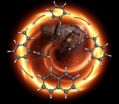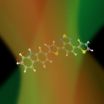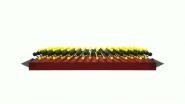(Press-News.org) Philadelphia, PA, July 1, 2014 – Research suggests that people at increased risk for developing addiction share many of the same neurobiological signatures of people who have already developed addiction. This similarity is to be expected, as individuals with family members who have struggled with addiction are over-represented in the population of addicted people.
However, a generation of animal research supports the hypothesis that the addiction process changes the brain in ways that converge with the distinctive neurobiology of the heritable risk for addiction. In other words, the more one uses addictive substances, the more one's brain acquires the profile of someone who has inherited a risk for addiction.
One such change is a reduction in striatal dopamine release. Dopamine is a key brain chemical messenger involved in reward-related behaviors. Disturbances in dopamine signaling appear to contribute to reward processing that biases people to seek drug-like rewards and to develop drug-taking habits.
In the current issue of Biological Psychiatry, researchers at McGill University report that individuals at high risk for addiction show the same reduced dopamine response often observed in addicted individuals, identifying a new link between addiction risk and addiction in humans.
Dr. Marco Leyton and his colleagues recruited young adults, aged 18 to 25, who were classified into three groups: 1) a high-risk group of occasional stimulant users with an extensive family history of substance abuse; 2) a comparison group of occasional stimulant users with no family history; and 3) a second comparison group of individuals with no history of stimulant use and no known risk factors for addiction. Volunteers underwent a positron emission tomography (PET) scan involving the administration of amphetamine, which enabled the researchers to measure their dopamine response.
The authors found that the high-risk group of non-dependent young adults with extensive family histories of addiction displayed markedly reduced dopamine responses in comparison with both stimulant-naïve subjects and non-dependent users with no family history.
"This interesting new parallel between addiction risk and addiction may help to focus our attention on reward-related processes that contribute to the development of addiction, perhaps informing prevention strategies," said Dr. John Krystal, Editor of Biological Psychiatry.
Leyton, a Professor at McGill University, said, "Young adults at risk of addictions have a strikingly disturbed brain dopamine reward system response when they are administered amphetamine. Past drug use seemed to aggravate the dopamine response also but this was not a sufficient explanation. Instead, the disturbance may be a heritable biological marker that could identify those at highest risk."
This finding suggests that there are common brain mechanisms that promote the use of addictive substances in vulnerable people and in people who have long-standing habitual substance use.
Better understanding this biology may help to advance our understanding of how people develop addiction problems, as well as providing hints related to biological mechanisms that might be targeted for prevention and treatment.
INFORMATION:
The article is "Reduced Dopamine Response to Amphetamine in Subjects at Ultra-High Risk for Addiction" by Kevin F. Casey, Chawki Benkelfat, Mariya V. Cherkasova, Glen B. Baker, Alain Dagher, and Marco Leyton (doi: 10.1016/j.biopsych.2013.08.033). The article appears in Biological Psychiatry, Volume 76, Issue 1 (July 1, 2014), published by Elsevier.
Notes for editors
Full text of the article is available to credentialed journalists upon request; contact Rhiannon Bugno at +1 214 648 0880 or Biol.Psych@utsouthwestern.edu. Journalists wishing to interview the authors may contact Dr. Marco Leyton at +1 514 398 5804 or marco.leyton@mcgill.ca.
The authors' affiliations, and disclosures of financial and conflicts of interests are available in the article.
John H. Krystal, M.D., is Chairman of the Department of Psychiatry at the Yale University School of Medicine, Chief of Psychiatry at Yale-New Haven Hospital, and a research psychiatrist at the VA Connecticut Healthcare System. His disclosures of financial and conflicts of interests are available here.
About Biological Psychiatry
Biological Psychiatry is the official journal of the Society of Biological Psychiatry, whose purpose is to promote excellence in scientific research and education in fields that investigate the nature, causes, mechanisms and treatments of disorders of thought, emotion, or behavior. In accord with this mission, this peer-reviewed, rapid-publication, international journal publishes both basic and clinical contributions from all disciplines and research areas relevant to the pathophysiology and treatment of major psychiatric disorders.
The journal publishes novel results of original research which represent an important new lead or significant impact on the field, particularly those addressing genetic and environmental risk factors, neural circuitry and neurochemistry, and important new therapeutic approaches. Reviews and commentaries that focus on topics of current research and interest are also encouraged.
Biological Psychiatry is one of the most selective and highly cited journals in the field of psychiatric neuroscience. It is ranked 4th out of 135 Psychiatry titles and 13th out of 251 Neurosciences titles in the Journal Citations Reports® published by Thomson Reuters. The 2012 Impact Factor score for Biological Psychiatry is 9.247.
About Elsevier
Elsevier is a world-leading provider of information solutions that enhance the performance of science, health, and technology professionals, empowering them to make better decisions, deliver better care, and sometimes make groundbreaking discoveries that advance the boundaries of knowledge and human progress. Elsevier provides web-based, digital solutions — among them ScienceDirect, Scopus, Elsevier Research Intelligence and ClinicalKey — and publishes nearly 2,200 journals, including The Lancet and Cell, and over 25,000 book titles, including a number of iconic reference works.
The company is part of Reed Elsevier Group PLC, a world-leading provider of professional information solutions in the Science, Medical, Legal and Risk and Business sectors, which is jointly owned by Reed Elsevier PLC and Reed Elsevier NV. The ticker symbols are REN (Euronext Amsterdam), REL (London Stock Exchange), RUK and ENL (New York Stock Exchange).
Media contact
Rhiannon Bugno
Editorial Office Biological Psychiatry
+1 214 648 0880
Biol.Psych@utsouthwestern.edu
The biology of addiction risk looks like addiction
Reports new study in Biological Psychiatry
2014-07-01
ELSE PRESS RELEASES FROM THIS DATE:
In study of individual neuron activity, key brain region responds to subjective perception
2014-07-01
LOS ANGELES (June 30, 2014) – When evaluating another person's emotions – happy, sad, angry, afraid – humans take cues from facial expressions. Neurons in a part of the brain called the amygdala "fire" in response to the visual stimulation as information is processed by the retina, the amygdala and a network of interconnected brain structures. Some of these regions respond just to the actual features of the face, whereas others respond to how things appear to the viewer, but it is unknown where in the brain this difference arises.
Although the amygdala's importance in ...
Up in flames: Evidence confirms combustion theory
2014-07-01
Researchers at the Department of Energy's Lawrence Berkeley National Lab (Berkeley Lab) and the University of Hawaii have uncovered the first step in the process that transforms gas-phase molecules into solid particles like soot and other carbon-based compounds.
The finding could help combustion chemists make more-efficient, less-polluting fuels and help materials scientists fine-tune their carbon nanotubes and graphene sheets for faster, smaller electronics. In addition, the results could have implications for the burgeoning field of astrochemistry, potentially establishing ...
Study finds online bullying creates off-line fear at school
2014-07-01
HUNTSVILLE, TX (7/1/14) -- Cyberbullying creates fear among students about being victimized at school, a recent study by Sam Houston State University found.
While traditional bullying still creates the most fear among students, cyberbullying is a significant factor for fear of victimization at school among students who have experienced bullying or disorder At school, such as the presence of gangs. The fear from cyberbullying is most prominent in minority populations.
"It cannot be overstated – online victimization has offline consequences, and those consequences may ...
Scientists discover how plastic solar panels work
2014-07-01
This news release is available in French.
Scientists don't fully understand how 'plastic' solar panels work, which complicates the improvement of their cost efficiency, thereby blocking the wider use of the technology. However, researchers at the University of Montreal, the Science and Technology Facilities Council, Imperial College London and the University of Cyprus have determined how light beams excite the chemicals in solar panels, enabling them to produce charge. "Our findings are of key importance for a fundamental mechanistic understanding, with molecular ...
Stanford engineers envision an electronic switch just 3 atoms thick
2014-07-01
VIDEO:
This animation shows the three-atom thick crystal being pulled from a non-conductive to conductive state, and then being pushed back to the non-conductive state.
Click here for more information.
Do not fold, spindle or mutilate. Those instructions were once printed on punch cards that fed data to mainframe computers. Today's smart phones process more data, but they still weren't built for being shoved into back pockets.
In the quest to build gadgets that can survive such ...
Updated guidelines covering fusion procedures for degenerative disease of the lumbar spine
2014-07-01
Charlottesville, VA (July 1, 2014). Experts in the spine surgery community—neurosurgeons and orthopedic surgeons—banded together to evaluate the recent literature on lumbar spine fusion procedures and to publish up-to-date evidence-based recommendations on their use. The Journal of Neurosurgery: Spine is pleased to announce today's publication of the American Association of Neurological Surgeons/Congress of Neurological Surgeons Joint Section on Disorders of the Spine and Peripheral Nerves' updated guidelines for the performance of fusion procedures for degenerative disease ...
Freeze-storage egg banking for egg donation treatment
2014-07-01
Munich, 1 July 2014: The rapid freezing technique of vitrification is set to revolutionise egg donation as a fertility treatment by enabling freeze-storage egg-banking. The cryopreservation of eggs was one of IVF's continuing challenges until the widespread introduction of vitrification; the older slow freezing methods induced the formation of ice crystals, which could cause damage to several structures of the egg. Thus, as demand for egg donation increases as a treatment for age-related infertility, egg banking with vitrification can theoretically provide a large pool ...
Preconceptional factors in the prediction of fertility and the reproductive lifespan
2014-07-01
Munich, 1 July 2014: A project in Denmark whose aim is to assess the reliability of preconceptional lifestyle and biological factors as predictors of fertility has found a pronounced effect of the contraceptive pill on markers used to assess "ovarian reserve", a predictor of future reproductive lifespan. Available evidence of whether the Pill has an effect on fertility has so far been reassuring - and usual advice to those stopping the Pill is that cycles will soon revert to normal, with pregnancy likely within six months or so.(1)
However, one continuing concern ...
Pregnancies following egg donation associated with more than 3-fold higher risk of hypertension
2014-07-01
Munich, 1 July 2014: With an ever-ageing female patient population, egg donation is an increasingly common treatment in infertility. ESHRE's own annual reports on fertility treatments in Europe show a rise in egg donation cycles from 15,028 in 2007 to 24,517 in 2010 (to 4.05% of all treatments). This proportion is still some way behind the USA, where egg donation now accounts for around 12% of all treatments.
As women age their store of viable eggs reduces such that their "ovarian reserve" (and likelihood of pregnancy) declines. Once the eggs have gone, they cannot be ...
Most women are aware of oocyte freezing for social reasons
2014-07-01
Munich, 1 July 2014: While the majority of younger women are aware of egg freezing as a technique of fertility preservation and consider it an acceptable means of reproductive planning, only one in five would consider it appropriate for them, according to the results of an internet survey performed in the UK and Denmark.
The questionnaire, which was accessible online, was completed anonymously by 973 women with a median age of 31 years between September 2012 and September 2013. Results are reported today at the ESHRE Annual Meeting in Munich by Dr Camille Lallemant of ...
LAST 30 PRESS RELEASES:
On-demand upgraded recycling of polyethylene and construction of sustainable multifunctional materials based on the "LEGO" strategy
New "Stomata in-sight" system allows scientists to watch plants breathe in real-time
Anorexia nervosa may result in long-term skeletal muscle impairment
Narrative-based performance reviews deemed fairest by employees
New insights reveal how advanced oxidation can tackle emerging water pollutants
New review shows how biomass can deliver low-carbon gaseous fuels at scale
Climate change is quietly rewriting the world’s nitrogen cycle, with high stakes for food and the environment
Study finds SGLT-2 inhibitors linked to lower risk of diabetic foot nerve damage
Microbes may hold the key to brain evolution
Study examines how the last two respiratory pandemics rapidly spread through cities
Gender stereotypes reflect the division of labor between women and men across nations
Orthopedics can play critical role in identifying intimate partner violence
Worms as particle sweepers
Second spider-parasitic mite described in Brazil
January 2026 issues of APA journals feature new research on autism, pediatric anxiety, psychedelic therapy, suicide prevention and more
Private equity acquired more than 500 autism centers over the past decade, new study shows
New cervical cancer screening guidelines from the US Department of Health and Human Services
Estimated burden of COVID-19 illnesses, medical visits, hospitalizations, and deaths in the US from October 2022 to September 2024
Smartphone use during school hours by US youth
Food insecurity and adverse social conditions tied to increased risk of long COVID in children
Earliest, hottest galaxy cluster gas on record could change our cosmological models
Greenland’s Prudhoe Dome ice cap was completely gone only 7,000 years ago, first GreenDrill study finds
Scientific validity of blue zones longevity research confirmed
Injectable breast ‘implant’ offers alternative to traditional surgeries
Neuroscientists devise formulas to measure multilingualism
New prostate cancer trial seeks to reduce toxicity without sacrificing efficacy
Geometry shapes life
A CRISPR screen reveals many previously unrecognized genes required for brain development and a new neurodevelopmental disorder
Hot flush treatment has anti-breast cancer activity, study finds
Securing AI systems against growing cybersecurity threats
[Press-News.org] The biology of addiction risk looks like addictionReports new study in Biological Psychiatry



